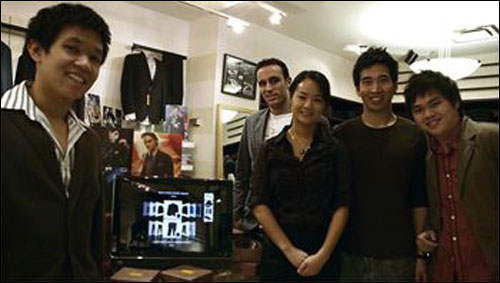Five graduate students at Carnegie Mellon University have designed a mirror system that includes an RFID interrogator and a touch-screen LCD monitor to provide consumers with information regarding clothing in a store as they shop. Since mid-December 2009, the system, known as the Smart.Mirror, has been trialed at Charles Spiegel for Men, a clothing boutique in Pittsburgh. Shoppers are using the system to learn more about a particular garment they have in hand, as well as which other items might go well with it. The system, says Charles Spiegel, the boutique’s owner and president, has generated frequent wows from customers, though he does not yet know whether it will provide a significant increase in sales.
The concept of RFID-enabled mirrors came about several years ago, according to software developer Kevin Chia and his partner, project manager Vincent Sethiwan. There were already several solutions available to retailers allowing consumers to hold a garment next to a mirror with a built-in reader to capture ID number encoded to that item’s RFID tag and then display information regarding that garment, along with other items that could accompany it (see Magicmirror Could Assist Retail Customers). However, Sethiwan says, they were relatively expensive and complex to establish. What the graduate students envisioned was a system comprising hardware that would be fairly inexpensive, as well as software that would provide the functions necessary to attract shoppers’ attention, without being as complex.

Sethiwan, Chia and several colleagues developed the system for an entrepreneurship competition known as the Keith Block Entrepreneurship Fund. After presenting the technology concept to the fund’s panel of judges, the group was awarded $3,000 in spring 2009 to further develop the idea. The team then began seeking a location at which they could try out the technology.
The graduate students visited a number of Pittsburgh stores, Sethiwan says, and gained the interest of Charles Spiegel, located in the city’s Squirrel Hill section. The team installed the prototype at the men’s store in December, requiring several days’ labor of about seven students affixing adhesive RFID tags to the existing bar-coded hangtags attached to 1,500 garments. The tags—Alien Technology‘s Higgs-3 ultrahigh-frequency (UHF) EPC Gen 2 tags—can be read from approximately 10 to 15 feet, Spiegel says. The installation also includes an Alien reader cabled to a PC that runs software Chia developed to link each tag’s unique ID number with information about complementary items that could be purchased to accompany that garment—such as a shirt that would go well with a specific jacket or sweater.
“We are focusing mainly on a simple solution that could be brought to market much faster” than other systems that utilize RFID technology to provide video content, Spiegel says.
“I know people have been saying the price of tags needs to be below five cents” in order to make a solution viable, Sethiwan notes, but he says he found that the tags the team purchased—priced at about 21 cents apiece—were, on average, approximately 13 cents more expensive than plain bar-coded hangtags. That extra 13-cent expense, he predicts, will be offset by the increased sales generated by the system.
The team expects that the primary customers for this system would be large retail chains, and plans to focus its next pilot project on that target market, in order to demonstrate that the system can work on a larger scale. The group also intends to develop two software packages, Chia says. One package would operate a simple smart mirror that would suggest other products that could complement a specific garment (similar to the PC system being tested at Charles Spiegel), while the other would operate a more expansive system that would be integrated with a store’s inventory system, and would support purchasing and inventory control, as well as the smart mirror.
At Charles Spiegel’s boutique, the RFID interrogator was installed at the end of an aisle toward the rear of the store. As customers come within 10 to 15 feet of it, the reader has been successfully capturing each garment’s ID number and then providing media content that is catching shoppers’ attention.
“At this point, it’s been great,” Spiegel says. “The RFID portion is working extremely well. I’d call it a resounding success.”
If used in a dressing room, the data could be displayed on or beside the mirror, with a reader prompting images to appear on a touch-screen LCD panel. According to the students, each interrogator would cost approximately $1,000.

